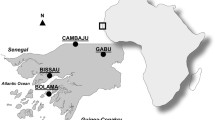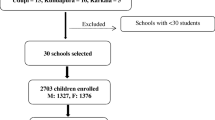Abstract
Endemic goiter in Morocco is localized in the Rif and Atlas mountains. In this study, performed in the Skoura-Toundoute areas (high Atlas),we demonstrate that iodine deficiency is the main factor involved in the development of endemic goiter. However it may not constitute the only etiological factor. The median urinary iodine excretion, measured on untimed samples, was low both in goitrous patients, m= 18 µg/l (n= 109) and in non goitrous subjects, m= 24 µg/l (n= 47). The value found in a nonendemic region (Casablanca) was much higher m= 117 µg/l (n= 67). Another approach to evaluate iodine intake per day was the analysis of iodine content of some samples of cereals (barley, wheat and corn), drinking water, sea and rock salt, cow and breast milk. Iodine content is low, specially in the endemic area: barley=90 µg/kg (n= 1); wheat= 227 µg/kg (n= 1); corn = 91 µg/kg (n= 1); water= 0.92 to 1.30 µg/l (n= 3); cow milk=6 to 33 µg/l (n= 10) breast milk=10 to 55 µg/l (n= 14); rock salt= 420 to 660 µg/kg (n= 8); sea salt= 90 to 160 µg/kg (n= 4). Sodium chloride intake per day, estimated by the measurement of sodium and chloride urinary excretion, is normal both in the Skoura-Toundoute areas (10.7 g and 9.8 g for goitrous and nongoitrous subjects, respectively) and in Casablanca (10.9 g for control persons). Altogether the results demonstrate the importance of introducing the practice of iodinated salt in the prophylaxis of endemic goiter in this area.
Similar content being viewed by others
References
Kelly F.C., Swedden N.N. Fréquence et repartition géographique du goitre endémique. In: Le goitre endémique. Monographie OMS, Genève, 1962, N0 44, p. 27.
Rhamoun O. Goitre endémique dans la région de Skoura. Thèse de médecine, Rabat, 1979.
Hennen G., Bensouda J.D., Vandalem J.L., Vanderheyde M.G. Physiopathologie des mécanismes de régulation de la secretion de thyrotropine chez l’homme. In: Carayon P. (Ed.), Exploration de la fonction thyroidienne. Bases physiologiques et applications cliniques. Merck-Clevenot, Paris, 1987, p. 83.
Beckers C., Benmiloud M. The present status of endemic goiter as a problem of the public health. 3. Africa In: Stanbury J.B., Hetzel B.S. (Eds.), Endemic goiter and endemic cretinism. John Wiley & Sons, New York, 1980, p. 72.
Ekpechi O.L. Iodine deficiency disorders in Africa. In: Hetzel B.S., Dunn J.T., Stanbury J.B. (Eds.), The prevention and control of iodine deficiency disorders. Elsevier, Amsterdam, 1987, p. 219.
Gaitan E., Lindsey R.H., Reichert R.D., Ingbar S.H., Cooksey R.C., Legan J., Meydrech E.F., Mill J., Kubote K. Antithyroid and goitrogenic effects of millet= role of C- glycosyl flavones. J. Clin. Endocrinol. Metab. 68: 707, 1989.
Aquaron R., Aquaron C., Daouda H., Madi N., Roux F., Bisset J.P. Etude de deux foyers d’endémie goitreuse au Niger, Belley-Koira et Tiguey-Tallawal. Ann. Endocrinol. (Paris) 51: 231, 1990.
Follis R.H. Patterns of urinary iodine excretion in goitrous and non goitrous areas. Am. J. Clin. Nutr. 4:253, 1964.
Bourdoux Ph. Measurement of iodine in the assessment of iodine deficiency. IDD Newsletter 4: 8, 1988.
Jeaulmes P., Hamelle G. Présence et taux des oligoéléments dans les aliments et les boissons de l’homme. Ann. Nutr. Alim. 25, B 133, 1971.
Hetzel B.S. Iodine deficiency disorders ( IDD ) and their eradication. Lancet 2: 1126, 1983.
Delange F., Thilly C., Ermans A.M. Iodine deficiency, a permissive condition in the development of endemic goiter. J. Clin. Endocrinol. Metab. 28: 114, 1968.
Aquaron R., Nguessi P, Ben Eno L, Riviere R. Le goitre endémique au Cameroun (province de l’Est et du Nord-Ouest). Rev. Franc. Endocrinol. Clin. 26: 537, 1985.
Aquaron R., Riviere R., Mendegris H., Martineaud M. Teneur en iode de l’eau de boisson et du sel de cuisine consommés au Cameroun dans les zones avec et sans endémie goitreuse. In: Lemonnier D., Ingenbleek Y. (Eds.), Les malnutritions dans les pays du Tiers-Monde. Colloque INSERM, Paris, 1986, vol.135, p. 437.
Aquaron R. Teneur en iode total des laits de femmes et des laits de vaches en France. In: Lemonier D., Ingenbleek Y., Hennart Ph. (Eds), Alimentation et nutrition dans les pays en developement, Kartala. ACCT. AUPELF, Paris, 1991, p. 585.
Delange F., Burgi H. Iodine deficiency disorders in Europe. Bull. World Health Organ. 67: 317, 1989.
Weber P., Manz F., Kersting M., Schoch G. Jodsalzverbrauch und Kocksalzumstatz. Dtsch. Med. Wschr. 111: 1916, 1986.
Kurtz T.W., Hamoundi M.D., Al-Bander M.D. Morris R.C. “Salt sensitive” essential hypertension in men. Is the sodium ion alone important? N. Engl. J. Med. 317: 1043, 1987.
Author information
Authors and Affiliations
Rights and permissions
About this article
Cite this article
Aquaron, R., Zarrouck, K., Jarari, M.E. et al. Endemic goiter in Morocco (Skoura-Toundoute areas in the high atlas). J Endocrinol Invest 16, 9–14 (1993). https://doi.org/10.1007/BF03345821
Received:
Accepted:
Published:
Issue Date:
DOI: https://doi.org/10.1007/BF03345821




